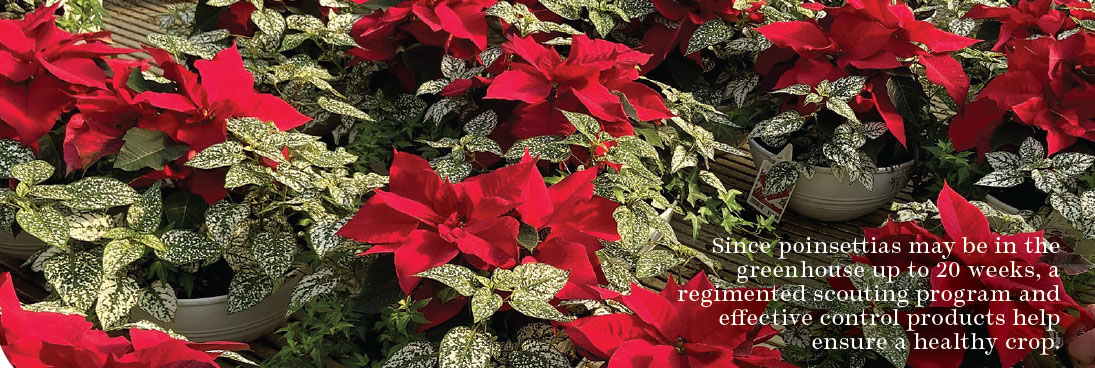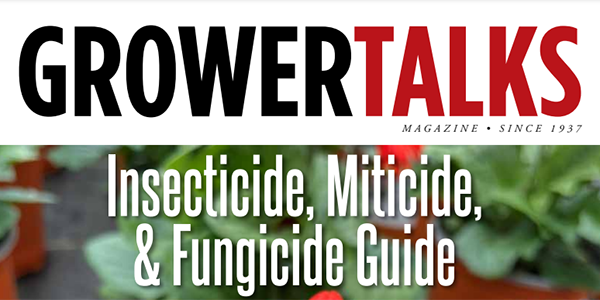Poinsettia prominence at Metrolina Greenhouses
Metrolina Greenhouses has refined its integrated pest management program to not only suppress pests and diseases, but to strengthen profits.

Poinsettias are the quintessential holiday crop and a valuable part of Metrolina Greenhouses’ plant palette. The North Carolina-based greenhouse fills more than 200 acres of space with 2.7 million poinsettias each year. The festive foliage is shipped to big-box stores in 15 states, primarily in the eastern part of the U.S.
This crop is not only important to the retailers who stock shelves with the popular plant for several weeks, but it’s also critical to Metrolina Greenhouses for keeping their staff working year-round, says Juan Ponce, director of horticulture.
Metrolina Greenhouses’ poinsettias range in size from pints up to 3 gallons, but the most common offering is a 3-quart container. They also produce poinsettias in hanging baskets and color bowls.
With the sheer number of poinsettias that are shipped from their greenhouse, plant health is critical. Ponce and his team have developed a laser-focused integrated pest management program to keep a steady stream of healthy plants being loaded from benches to trucks.
“Poinsettias are anywhere from 15 to 20 weeks in the greenhouse, and that’s a long production time where a lot of things could go wrong,” Ponce says.
For instance, pectobacterium (formerly known as erwinia) can show up during the first five days of propagation. Soon afterward, there’s a chance for pythium to strike the crop. Once the plant is forming bracts, there’s a chance for bacterial spots, although that’s not a common problem with poinsettias, Ponce explains.
“We only get one chance when bracts start forming, so growers have to be very careful during this stage,” he adds.
After the bracts have formed and the plant has a little more growth on it, the team must watch for botrytis and powdery mildew.
For insect pests, whiteflies are the No. 1 issue on poinsettias, especially Bemisia tabaci Q biotype, Ponce says.
“In the industry there have been some resistance issues with the Q biotype, but our IPM program prevents that from happening,” he adds.
Last year Metrolina Greenhouses dealt with Lewis mites, which isn’t a typical pest they see on poinsettia.
“Lewis mite damage resembles nutritional deficiencies until you see distortion in the leaves. And then it’s a problem because that means they’re established,” Ponce says. “So it’s important to ID them early. If you see one little yellow spot on the leaf, it’s probably a Lewis mite instead of a nutritional issue.”
Thrips and mealybugs are other pests that can cause problems with poinsettias. And with the current concerns about Thrips parvispinus, Ponce is helping his team ID that newly worrisome pest.
“I’m more worried about parvispinus on mums and some of our annuals,” he says. “They haven’t been reported on poinsettias yet, but thrips can easily adapt to new and different crops, so our scouts will need to be at a level where they can ID that species.”
When there are so many pests and diseases that are known to affect poinsettias, the key is to start clean and stay clean, Ponce says. It’s a principle he instills in every member of his team. Scouting is a critical part of starting clean.
“Our scouts are very well trained. And if they can’t ID something, we have an internal lab that can help,” he explains. “Scouting really is the most important part of IPM. Every assistant and every grower acts as a scout. That way we have more eyes on the plants.”
Another important aspect of IPM is information, something that’s often overlooked in the industry, he says. “Information should be part of IPM. We like to share information and learn from others,” he adds. The team also uses yellow sticky cards. They place 1 per 2,000 square feet and examined after 24 hours of being placed. They’re replaced weekly throughout Metrolina Greenhouses’ 230 acres of greenhouse space. Crews also beat leaves onto white or black paper, which helps spot pests that aren’t on sticky cards, such as spider mites.
Ponce relies heavily on biological controls and he looks for bioinsecticides that are compatible with his program.
“We use biocontrols because they’re successful and we use bioinsecticides because they have lower residual effects,” Ponce explains. “With biologicals, we can start soft and then structure our program to use stronger pesticides toward the end.” When controlling thrips, it’s critical to kill all the life stages. Metrolina Greenhouses’ IPM program and use of biocontrols coupled with biorationals accomplishes that.
“The best killer of adult thrips is Orius. Then beneficial mites like cucumeris are great for nymphs. We use beneficial nematodes for pupae in the soil and then we can use chemistry to keep the populations low,” he says. “A lot of people talk about the triangle of disease, but I talk about the triangle of the beneficial.”
Ponce’s crew uses Sultan® miticide often in propagation when the plants are rooted to combat twospotted spider mites. “Sultan doesn’t hurt our beneficial mites. We can apply Sultan and know that in three days we can release biocontrols,” he says.
His team uses Ventigra® insecticide against aphids and other sucking insects. “We use Ventigra in the same way we use Sultan. We use it to clean up pests and then release beneficials to do the rest. We also use Ventigra close to shipping as a preventive.”
Velifer® fungal contact miticide/insecticide works well in the TracFog system, Ponce explains, and it keeps a general population of pests down with low impacts on beneficials. “And on poinsettias, Velifer is safe on bracts as they start to color and it won’t burn the bracts,” he adds.
Velifer Fungal Contact Miticide/ Insecticide
Active Ingredient: Beauveria bassiana strain PPRI 5339
REI: 12 hours
Target Pests: Whiteflies, thrips, mites, mealybugs, aphids
Ventigra Insecticide
Active Ingredient: Afidopyropen
REI: 12 hours
Target Pests: Aphids, whiteflies, mealybugs
Sultan Miticide
Active Ingredient: Cyflumetofen
REI: 12 hours
Target Pests: Spider mites
Always read and follow label directions. Sultan, Velifer and Ventigra are registered trademarks of BASF.




